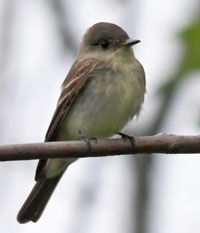Eastern wood-pewee
Scientific name: Contopus virens

Cover photo credit: © Josh Vandermeulen CC BY-NC
Status
Special Concern
“Special Concern” means the species lives in the wild in Ontario, is not endangered or threatened, but may become threatened or endangered due to a combination of biological characteristics and identified threats.
Date added to the Species at Risk in Ontario List
June 27, 2014
Read the report (PDF)
What it looks like
The eastern wood-pewee is a small forest bird that grows to about 15 cm long. Adults are generally greyish-olive on their upper parts and pale on the under parts with pale bars on their wings. Males and females are similar in appearance.
The eastern wood-pewee has a distinctive, clear, three-part song, usually recorded as “pee-ah-wee.”
This bird is often observed perched in an upright position. It eats mostly small, flying insects.
Where it lives
The eastern wood-pewee lives in the mid-canopy layer of forest clearings and edges of deciduous and mixed forests. It is most abundant in intermediate-age mature forest stands with little understory vegetation.
Where it’s been found in Ontario
The eastern wood-pewee is found across most of southern and central Ontario, and in northern Ontario as far north as Red Lake, Lake Nipigon and Timmins.
View a Larger version of this map (PDF)
What threatens it
Possible threats to the eastern wood-pewee are poorly known but may include:
- loss and degrading of habitat due to urban development and/or changes in how forests are managed
- reductions in the availability of the flying insects they eat, the cause of which is not known
- loss of eggs and fledgling birds from increasing numbers of predators such as blue jays and red squirrels
- changes to the make-up of forests due to white-tailed deer over-browsing, which may reduce the number of insects available to eat
These birds may also face other threats during their migration and in their wintering habitat in South America.
Action we are taking
Special concern species do not receive species or habitat protection.
What you can do
Report a Sighting
- The Ministry of Natural Resources tracks species at risk such as the eastern wood-pewee. You can use a handy online form to report your sightings to the Natural Heritage Information Centre. Photographs with specific locations or mapping coordinates are always helpful.
Volunteer
- Volunteer with your local nature club or provincial park to participate in surveys or stewardship work focused on species at risk.
Be a good steward
- Private land owners have a very important role to play in species recovery. You may be eligible for stewardship programs that support the protection and recovery of species at risk and their habitats.
- Bird Studies Canada is working to advance the understanding, appreciation and conservation of wild birds and their habitat in Ontario and elsewhere. For more information on how you can help, visit: www.bsc-eoc.org.
- As with all wildlife, don’t disturb or harass the birds or nesting sites. Be respectful and observe from a distance.
Report illegal activity
- Report any illegal activity related to plants and wildlife to 1-877-TIPS-MNR (847-7667).
Quick facts
- When several species of “flycatchers” – birds that eat flying insects – live in the same forest, they each find their niche. The eastern wood-pewee tends to forage higher in the trees than the least and Acadian flycatchers, but lower than the great crested flycatcher.
- The eastern wood-pewee’s nest is so well camouflaged that it often just seems like a knot on the tree’s branch.
- The eastern wood-pewee is almost impossible to tell apart from the western wood-pewee by sight, but can be distinguished by its different call.
- The breeding ranges of the eastern and western wood-pewee overlap in a small region in the American Great Plains, but the two species do not appear to interbreed.
